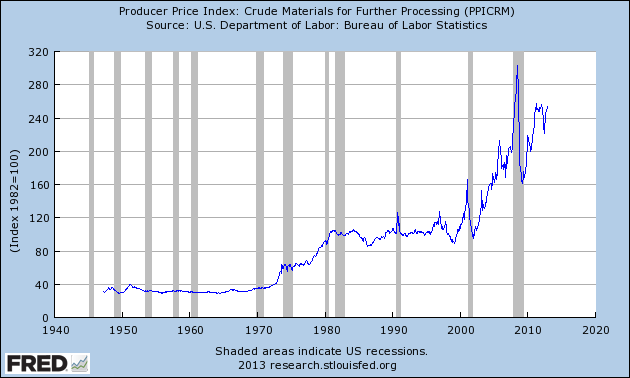This an excerpt from a blog post by Robert Higgs posted here. Nice corollary to the "Where is the Inflation" Piece I reprinted from Mises Institute.
------------------------------------------------------------------------------------------------------
As the chart shows, the producer price index (PPI) for crude materials has followed a quite different historical path from the CPI. Since World War II, it has passed through four distinct phases: I, no-growth stability from the late 1940s to the early 1970s; II, rapid increase in two bursts between 1972 and 1981; III, no growth (but with much greater variance than in phase I) between 1981 and 2001; and IV, rapid growth with even greater variance from 2002 to 2012.

Austrian thinking associates the rapid run-up of crude materials prices in phases II and IV with a flight from monetary assets, whose real values are falling or expected to fall. Investors seek the safe haven of real assets as the Fed engages in sustained easy-money policies. In addition, producers bid up disproportionately the prices of “early stage” goods required for undertaking the longer-term projects that artificially reduced interest rates encourage.
Whereas the CPI increased by 30.2 percent between December 2001 and December 2012, the PPI for crude materials increased by 166.4 percent during this period .
With the onset of the financial panic in the second half of 2008 and the economic contraction that accelerated between mid-2008 and early 2009, the PPI dropped almost by half. Since then, however, crude materials prices have increased relatively rapidly, rising by 58 percent between March 2009 and December 2012, far outpacing the increase in the CPI and maintaining a rate of increase comparable to that between 2002 and mid-2008.
-----------------------------------------------------------------------------------------------------
So why has the rise in commodity prices not shown up in consumer goods? I have to do some digging on this but working hypothesis it has been a combination of productivity, packaging/product manipulations, and global competition that has led to the containment of end product consumer goods.
------------------------------------------------------------------------------------------------------
As the chart shows, the producer price index (PPI) for crude materials has followed a quite different historical path from the CPI. Since World War II, it has passed through four distinct phases: I, no-growth stability from the late 1940s to the early 1970s; II, rapid increase in two bursts between 1972 and 1981; III, no growth (but with much greater variance than in phase I) between 1981 and 2001; and IV, rapid growth with even greater variance from 2002 to 2012.

Austrian thinking associates the rapid run-up of crude materials prices in phases II and IV with a flight from monetary assets, whose real values are falling or expected to fall. Investors seek the safe haven of real assets as the Fed engages in sustained easy-money policies. In addition, producers bid up disproportionately the prices of “early stage” goods required for undertaking the longer-term projects that artificially reduced interest rates encourage.
Whereas the CPI increased by 30.2 percent between December 2001 and December 2012, the PPI for crude materials increased by 166.4 percent during this period .
With the onset of the financial panic in the second half of 2008 and the economic contraction that accelerated between mid-2008 and early 2009, the PPI dropped almost by half. Since then, however, crude materials prices have increased relatively rapidly, rising by 58 percent between March 2009 and December 2012, far outpacing the increase in the CPI and maintaining a rate of increase comparable to that between 2002 and mid-2008.
-----------------------------------------------------------------------------------------------------
So why has the rise in commodity prices not shown up in consumer goods? I have to do some digging on this but working hypothesis it has been a combination of productivity, packaging/product manipulations, and global competition that has led to the containment of end product consumer goods.
No comments:
Post a Comment